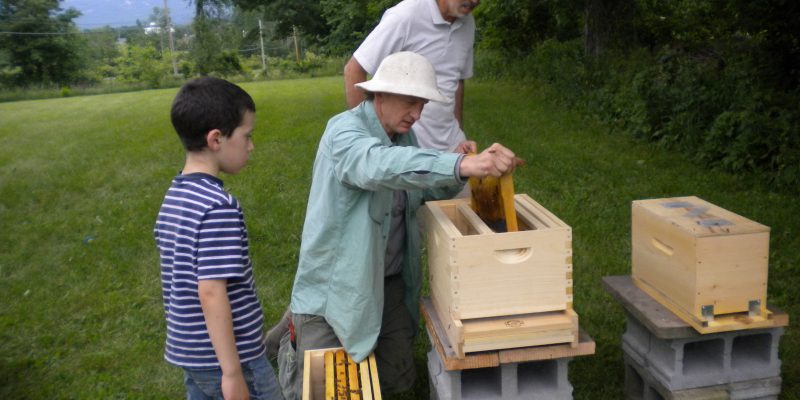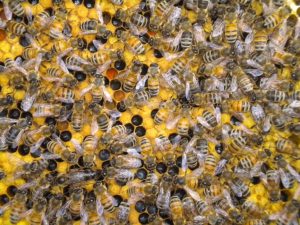
What do you do if you are a farmer concerned about your crops and the disappearance of honeybees, known as Colony Collapse Disorder, or CCD? Bart Colucci and his son, Tom, decided to take up beekeeping, which Tom describes as a “big faith walk.” They bought the materials for three eight-frame hives. Two of the hives are NUCs, a nucleus of a hive complete with a queen bee. Each NUC contains 15,000 to 18,000 bees. The third is an empty hive which they hope will attract a “swarm,” which is a colony of bees following an outcast queen in search of a home.
A hive consists of several compartments called “supers,” which each contain eight frames, and in each frame is a “foundation,” a waxy filament which gives the bees a start. Tom took two courses with New Paltz beekeeper Chris Harp, who has been a beekeeper for twenty years, and Tom and Bart have been planning their venture for months.
The intensive work of nailing all these parts together—it took Tom four hours to unload the materials and build one hive— was followed by choosing a location for the hives that provided a wind barrier, warmth in winter and protection from predators. Honey is produced in the outer frames, producing heat and insulation. Bears can be a problem, and I’m sorry to debunk some much-loved children’s stories but, in fact, they are not after the honey. They are after the protein in the brood larvae! Bart’s and Tom’s focus is also on the bees rather than the honey.
There is no clear cause of CCD, and there may be many contributing factors such as mites, pesticides and depleting agricultural methods of monoculture in which trucks of hives are hauled from place to place. Whatever the cause, small colony beekeepers like Bart and Tom are consuming a vast amount of information on bees and becoming quite enamored of them. “Such intelligence,” Tom said more than once, “such intelligence.”
June fifth was the magic day when the Russian bees arrived, via Chris, from a supplier near Harrisburg, PA. Chris prefers Russian bees over the more popular Italian bees because they have good resistance to parasites, including varroa, which is a primary killer of bees. The first step was to prepare the site by leveling it and laying concrete blocks on the ground to keep out skunks. Next was preparing the smoker to subdue the bees. Actually it didn’t work very well and seemed to be unnecessary; these bees are not aggressive if the handlers are quiet, avoid sudden frightening movements and do not interfere with them for an extensive length of time. Note that in the photos no one, even Tom’s young son, is wearing protective gear.
Then the big moment: transferring the bees! It was very exciting to locate the queen bee, who is darker and a different shape  from the others. Can you find her in the photo on page nine? In the 7,000 cells of the frame we could see the worker bees, the rice-like brood eggs in the cells, and the honey. One pound of honey requires five million flowers! Bees in commercial grower fields tend to be restricted and limited by exposure to only one flower, whereas Bart’s bees in their natural surroundings will have access to many varieties. Even Purple Loosestrife, dismissed by many as an alien nuisance, can be quite beneficial. During droughts Loosestrife, because of its preference for a wet environment, produces nectar for bees. A side note: Chris cautioned that you never want to walk up to a hive with a banana, as the scent of the banana will provoke them to sting! Otherwise the bees rarely attack unless you mistakenly smoosh one, which is fairly easy to do.
from the others. Can you find her in the photo on page nine? In the 7,000 cells of the frame we could see the worker bees, the rice-like brood eggs in the cells, and the honey. One pound of honey requires five million flowers! Bees in commercial grower fields tend to be restricted and limited by exposure to only one flower, whereas Bart’s bees in their natural surroundings will have access to many varieties. Even Purple Loosestrife, dismissed by many as an alien nuisance, can be quite beneficial. During droughts Loosestrife, because of its preference for a wet environment, produces nectar for bees. A side note: Chris cautioned that you never want to walk up to a hive with a banana, as the scent of the banana will provoke them to sting! Otherwise the bees rarely attack unless you mistakenly smoosh one, which is fairly easy to do.
Bart and Tom now plan to build a lean-to around the hives and install an electric wiring system to deter bears. They will monitor the hives every two weeks, gently prying open the covers in order to not upset the bees. To quote Chris Harp: “A house with bees is blessed. They create no structural damage.”
